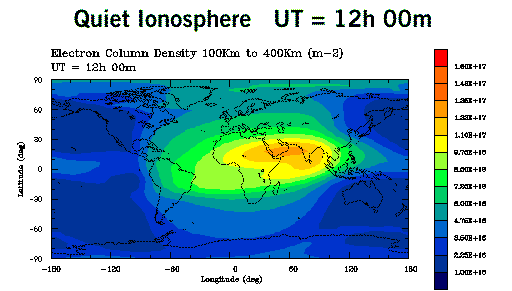(10) An Average Day in the Life of the Ionosphere

(movie courtesy of A. Burns, T. Killeen and W. Wang at the University of Michigan)
About the movie: You are viewing a 24-hour long simulation of the total electron content in a column above the Earth's surface (100-400 kilometers in altitude) from 12:00 UT on April 9 to 12:00 UT on April 10, 1997. This was a rather quiet 24-hour period with moderate sporadic magnetic activity. The ionosphere is most dense on the dayside just after local noon and becomes very tenuous during the night. (Click here to see how Universal Time, UT, relates to local time). Occasional precipitation of high energy particles at high latitudes can be seen as temporary enhancements in the total electron content near +75 degrees latitude. Dramatic changes in this pattern are seen during ionospheric storms.
Click here to view an ionospheric storm that occurred just after this quiet day.
|
Basic Facts About the Ionosphere
- Invisible layers of ions and electrons are suspended in the Earth's atmosphere above about 60 kilometers in altitude.
- The main source of these layers is the Sun's ultraviolet light which ionizes atoms and molecules in the Earth's upper atmosphere. During this process, called photoionization, an electron is knocked free from a neutral atmospheric particle, which then becomes an ion.
- Because the Sun's light is responsible for most of the ionization, the ionosphere reaches maximum densities just after local noon. In this region at altitudes where the highest densities occur, about one in every 1000 air particles is ionized. Resulting ionospheric densities are ~ a million ions and electrons per cubic centimeter.
- Ion - electron pairs are also created during collisions of high velocity electrons and ions with the neutral atmosphere mostly at polar and auroral latitudes.
- Flares and other energetic events on the Sun produce increased ultraviolet, x-ray and gamma-ray photons that arrive at the Earth just 8 minutes later and dramatically increase the density of the ionosphere on the dayside. These solar events also can produce high velocity protons and electrons (arriving at Earth hours to days later) that precipitate into the ionosphere in the polar regions producing large increases in the density of the ionosphere at low altitudes.
- Ions and electrons in the ionospheric layer are constantly being lost and replenished. The lifetime of a given ion is only a fraction of a day and decreases with decreasing altitude. Lower altitude ions have shorter lifetimes.
- The low-altitude portion of the ionosphere (D and E-layers) rapidly reaches low densities at night because ion and electron lifetimes are very short at these altitudes and the major source of new ion-electron pairs (solar photons) is absent.
Points of Interest
The atmosphere's ionization layers make possible long distance radio communication by reflecting the radio waves back to Earth. They also are home to the aurora and the mega-ampere currents that heat the atmosphere at high latitudes during geomagnetically active times. During storms depletions and enhancements of ionization occur depending on the local time and geographical location. Depletions are particularly effective at causing problems with the normal operation of radio communications. Global look at the difference between quiet and active times using the Global Positioning System (GPS) ground receiver network.
|






